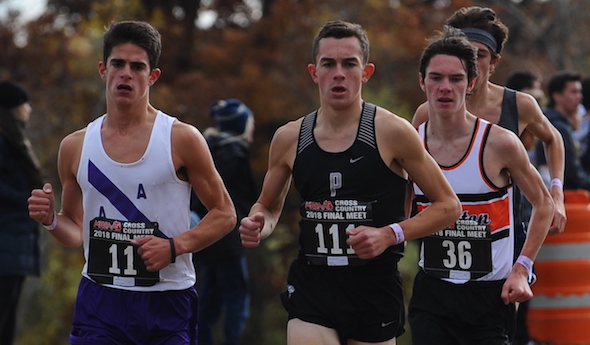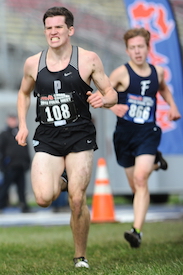
Plymouth Wins 1st Title, Foster Wins 2nd
November 3, 2018
Second Half reports
BROOKLYN — Carter Solomon doesn’t mind losing a cross country race.
For the Plymouth junior, it’s all about the competition.
He got plenty in the form of Ann Arbor Pioneer senior Nick Foster, but Solomon got the victory he really wanted by leading Plymouth to its first championship at the MHSAA Lower Peninsula Division 1 meet Saturday at Michigan International Speedway.
The Wildcats were runners-up by three points last year, but came through in another close meet to edge surprising Walled Lake Central, 122-127.
Walled Lake Central came into the meet ranked No. 11, but this meet didn’t necessarily go according to form, with the exception of Plymouth. The Wildcats were ranked No. 1, but none of the other teams ranked in the top three finished there when it mattered most.
“I’m so proud of those guys after last year being runner-up,” Plymouth coach Jon Mikosz said. “To have the pressure on them all year and to be able to come back and pull it off is amazing.”
Solomon led the way, finishing second in 15:18.1. He battled Foster, the reigning champion, step for step until the Pioneer senior pulled away with the finish line in sight to win in 15:13.0.
 “Unfortunately, this is only the second time I’ve raced him this year,” Solomon said. “The previous year, we raced three or four times. I love racing against him. I love racing against competition. It makes the race that much more fun.
“Unfortunately, this is only the second time I’ve raced him this year,” Solomon said. “The previous year, we raced three or four times. I love racing against him. I love racing against competition. It makes the race that much more fun.
“I love going out to races like this and testing myself. In a few weeks, I’m going to the Foot Locker regional. I know that’s a really stacked race. I’m super excited for that. I knew Nick was going to be there the whole race. He closed a lot harder than I did.”
Foster and Solomon were part of a five-man lead pack at the two-mile mark. Foster said he believed he could prevail if it came down to a kick at the end.
“I was pretty confident,” he said. “I knew a couple of those guys can finish pretty strong. I knew it wouldn’t come easy. With 700 meters to go, I felt good. I knew Carter was on me. I just had to keep going right through the finish. It was tough, but this is my third year doing it, so I knew it was going to be tough. But, like last year, I realized I have more left than I think.”
Walled Lake Central ran with a tight pack, its five scoring runners separated by only 16.2 seconds. The Vikings couldn’t overcome Plymouth’s strength near the front.
Following Solomon for the Wildcats were sophomore Patrick Byrnes (15th, 15:56.2), senior Brandon Boyd (33rd, 16:13.8), senior Jarrett Warner (60th, 16:31.9) and junior Tyler Mussen (63rd, 16:34.8).
PHOTOS: (Top) Ann Arbor Pioneer’s Nick Foster (11), Plymouth’s Carter Solomon (111) and Brighton’s Zachary Stewart (36) lead the pack near the midway point of the Division 1 Final. (Middle) Plymouth’s Patrick Byrnes pushes down the final stretch. (Click for more from RunMichigan.com.)

MHSAA Vault: MIS Rose to Challenges to Host 2020 LP Finals
By
Rob Kaminski
MHSAA benchmarks editor
November 12, 2021
The “MHSAA Vault” features stories from past publications and other documents in the MHSAA Library. This issue takes a look at the MHSAA Cross Country Finals at Michigan International Speedway, which celebrated 25 years in 2020 – although it was an event that nearly didn’t happen last fall …
In 1996, the MHSAA and Michigan International Speedway began a partnership the changed the course of the Lower Peninsula Cross Country Finals – quite literally.
The land in and around the track at Brooklyn would host the Finals for all classes of runners in one place on one day, an annual festival of nearly 2,000 runners competing for the MHSAA’s top honors.
Even skeptics – and there were several among running purists who thought the course was too flat, for example – can’t deny the results.
Finals attendance nearly doubled in that first year, and crowds in excess of 10,000 have enjoyed a day of racing several times, including a record 12,153 in 2011.
Enthusiastic crowds were the norm in recent years, with 11,232 in 2017, and nearly 11,000 in 2018 (10,989) and 2019 (10,873).
In fact, attendance failed to reach at least 8,000 only twice since the move to MIS.
Of course, last year was an exception, when attendance was limited to 1,000 spectators per session due to the COVID-19 Pandemic. Fans also were restricted to the grandstands rather than following the action throughout locations on the course.
To reduce the number of runners in each race, the event was spread over two days, with each Division being run in two separate “sections” with times then combined at the end to determine team and individual champions.
While not ideal, the end result was another year of fantastic efforts at MIS – both from student-athletes and those behind the scenes.
“Even at the last hour, less than a week ahead of the Finals, we were closer to not having the Finals than we were to having them,” said MHSAA Assistant Director Cody Inglis, who coordinates the cross country postseason. “Rumors and challenges of mandated shutdowns, testing and other requirements were being discussed and caused a lot of unknowns. Even at the Regional level, we had schools, Regional courses and hosts shutting down their facilities; we had to relocate four Regionals 48 hours prior to race times. That scenario just could not happen at the Finals level where far more runners and much more travel would be involved.”
Among the many last-minute hurdles was the edict from NASCAR – which owns MIS – that all persons on site be temperature checked upon entry. That meant securing thermometers that were easy to operate in short order, along with personnel necessary to conduct the readings.
The attendance limitations certainly helped to implement the temperature screening, but brought their own issues.
“Limiting spectators was not a popular decision, but it really was the only way to have a race,” Inglis said. “We were taking direction and working with policies and protocols from the MDHHS, the Governor’s office, Lenawee County Health Department, MIS and NASCAR.”
Part of the solution was to utilize the grandstands as a “barrier” between participants and spectators. The reduced number of fans were dispersed over thousands of seats while still allowing them the chance to watch their student-athletes compete.
“It wasn’t the same, it wasn’t easy or perfect, but it was what we had to do to have a race,” Inglis said. “Separating the Finals into two days and different sections also allowed us to spread out the event and limit the number of people on site at any one time. This was a key part of the plan and worked well even though it separated races within a Division.”
The MHSAA, MIS and the cross country community never lost focus of the main goal: a culmination of the season for the student-athletes, who deserved something last year more than ever. And, more than ever, MIS once again displayed its advantage as a venue that could adapt to the fluid nature of the times to pull off the event.
“There were some thoughts of using four different sites, but as we learned during the Regionals, the climate of things was so tenuous from one area of the state to another that we couldn’t be 100-percent certain that there wouldn’t again be last-minute cancelations,” Inglis said. “MIS was wonderful to work and collaborate with, and was the best option to get it done. It was never mentioned once publicly about the possibility of not having the Finals – only how we could best do it under uncharted conditions.”
The moving parts and ever-changing scenarios created more complexity than ever in finalizing a season, but every decision was made with the complete desire to conduct the Finals as close to normal as possible.
“I firmly believe that a finish to the season, no matter the differences in race formatting and fan experience, was something everyone would have taken when the season began in August,” Inglis said.
Indeed, the finish line in Year 25 at MIS might have been the most gratifying of them all.

